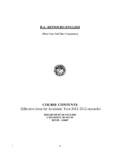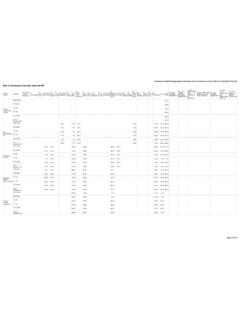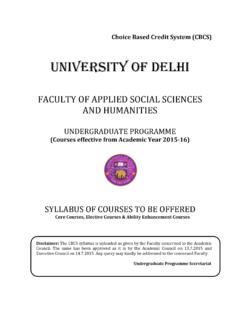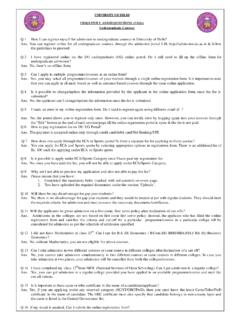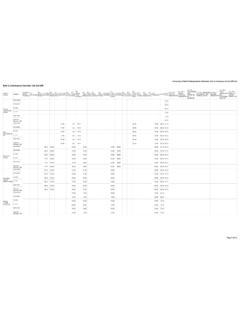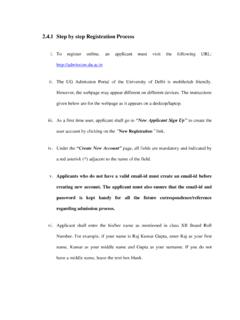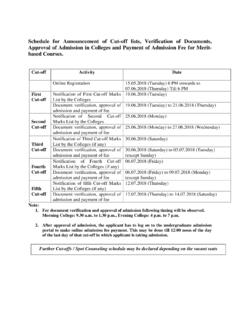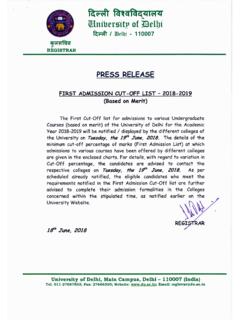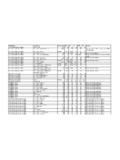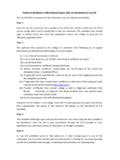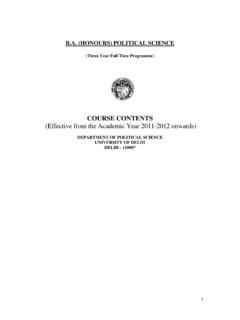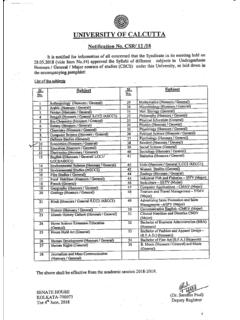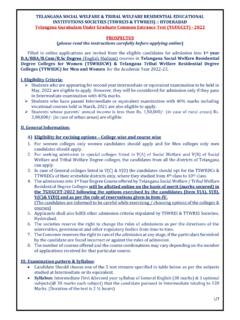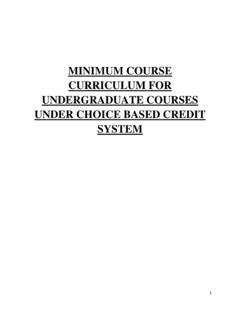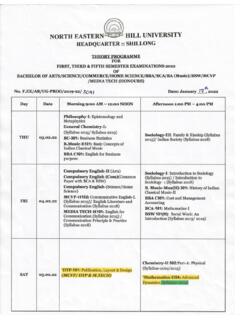Transcription of B.A. (HONOURS) ECONOMICS - Delhi University
1 1 ( honours ) ECONOMICS (Three Year Full Time Programme) COURSE CONTENTS (Effective from the Academic Year 2011-2012 onwards) DEPARTMENT OF ECONOMICS University OF Delhi Delhi 110007. 2 University of Delhi Course: (Hons.) ECONOMICS Semester I Paper 01 Introductory Microeconomics Paper 02- Statistical Methods in ECONOMICS -I Paper 03 - Mathematical Methods for ECONOMICS -I Paper 04 - Concurrent Qualifying Language Semester II Paper 05 Introductory Macroeconomics Paper 06 Statistical Methods in ECONOMICS -II Paper 07 - Mathematical Methods for ECONOMICS -II Paper 08 - Concurrent Credit Language Semester III Paper 09 Intermediate Microeconomics-I Paper 10 Intermediate Macroeconomics-I Paper 11 - economic History of India.
2 1857-1947 Paper 12 - Introductory Econometrics Paper 13 - Concurrent Interdisciplinary Semester IV Paper 14- Intermediate Microeconomics-II Paper 15 - Intermediate Macroeconomics-II Paper 16 Economy, State and Society Paper 17 - Indian economic Development since 1947 - I Paper 18 - Concurrent Discipline Centered I Semester V Paper 19- Indian economic Development since 1947 - II Paper 20 Development Theory and Experience-I Paper 21 Public ECONOMICS Paper 22 Option -I (any one from List of Group-I) Group-I 22A - ECONOMICS of Health and Education 22B - Political Economy 22C - Topics in Microeconomics-I 22D - Advanced Macroeconomics 22 E - Money and Financial Markets 3 Semester VI Paper 23 International ECONOMICS Paper 24- Development Theory and Experience-II Paper 25- Option-II (any one from List of Group-II) Group II 25A - Comparative economic Development.
3 1850- 1950 25B - Applied Econometrics 25C - Topics in Microeconomics-II 25D - Financial ECONOMICS 25E - Environmental ECONOMICS Paper 26 - Concurrent Discipline Centered II 4 SEMESTER BASED UNDER-GRADUATE honours COURSES Distribution of Marks & Teaching Hours The Semester-wise distribution of papers for the ( honours ), ( honours ), B. Com., ( honours ) statistics and ( honours ) Computer Science will be as follows: Type of Paper Max. MarksTheory Exam. Teaching per week Main Papers 100 75 25 5 Lectures 1 Tutorial Concurrent Courses 100 75 25 4 Lectures 1 Tutorial Credit Courses for (Hons.)
4 Mathematics 100 75 25 4 Lectures 1 Tutorial Size of the Tutorial Group will be in accordance with the existing norms. The existing syllabi of all Concurrent/Credit Courses shall remain unchanged. The existing criteria for opting for the Concurrent /Credit Courses shall also remain unchanged. 5 Paper 01: INTRODUCTORY MICROECONOMICS Course Description This course is designed to expose first-year students, who may be new to ECONOMICS , the basic principles of microeconomic theory.
5 The emphasis will be on thinking like an economist and the course will illustrate how microeconomic concepts can be applied to analyse real-life situations. Course Outline 1. Exploring the subject matter of ECONOMICS Why study ECONOMICS ? The scope and method of ECONOMICS ; scarcity and choice; questions of what, how and for whom to produce and how to distribute output; the basic competitive model; prices, property rights and profits; incentives and information; rationing; opportunity sets; economic systems; reading and working with graphs.
6 2. Supply and Demand: How Markets Work, Markets and Welfare Individual demand and supply schedules and the derivation of market demand and supply; shifts in demand and supply curves; the role prices in resource allocation; the concept of elasticity and its application; consumer and producer surplus; taxes and their efficiency costs 3. Households The consumption decision: preferences and their representation with indifference curves; budget constraints; a consumer s optimum choice; income and substitution effects; labour supply and savings decisions.
7 4. Firms and Perfect Market Structure Behaviour of profit maximizing firms and the production process; short-run costs and output decisions; costs and output in the long run. 5. Imperfect Market Structure Monopoly and anti-trust policy; government policies towards competition; imperfect competition. 6. Input Markets Labour and land markets; concepts of derived demand, input productivity and marginal revenue product and input demand curves; competitive input markets and public policy. Readings 1.
8 Karl E. Case and Ray C. Fair, Principles of ECONOMICS , Pearson Education, Inc., 8th edition, 2007. 2. N. Gregory Mankiw, ECONOMICS : Principles and Applications, India edition by South Western, a part of Cengage Learning, Cengage Learning India Private Limited, 4th edition, 2007. 3. Joseph E. Stiglitz and Carl E. Walsh, ECONOMICS , Norton & Company, Inc., New York, International Student Edition, 4th edition, 2007. 6 Paper 02: STATISTICAL METHODS IN ECONOMICS I Course Description This is the first of a two-part sequence on statistical methods.
9 It begins with some basic concepts and terminology that are fundamental to statistical analysis and inference. It then develops the notion of probability, followed by probability distributions of discrete and continuous random variables. The semester concludes with a discussion of joint distributions. Course Outline 1. Introduction and Overview The distinction between populations and samples and between population parameters and sample statistics ; the use of measures of location and variation to describe and summarize data; population moments and their sample counterparts.
10 2. Elementary Probability Theory Sample spaces and events; probability axioms and properties; counting techniques; conditional probability and Bayes rule; independence. 3. Random Variables and Probability Distributions Defining random variables; probability distributions; expected values of random variables and of functions of random variables; properties of commonly used discrete and continuous distributions (uniform, binomial, normal, poisson and exponential random variables). 4. Random Sampling and Jointly Distributed Random Variables Density and distribution functions for jointly distributed random variables; computing expected values; covariance and correlation coefficients.
